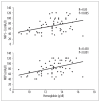Respiratory pressures and expiratory peak flow rate of patients undergoing coronary artery bypass graft surgery
- PMID: 22936191
- PMCID: PMC3560654
- DOI: 10.12659/msm.883351
Respiratory pressures and expiratory peak flow rate of patients undergoing coronary artery bypass graft surgery
Abstract
Background: To evaluate clinical and laboratorial parameters that predict decreased respiratory function in patients subjected to coronary artery bypass graft surgery (CABG).
Material/methods: This was a prospective study evaluating 61 patients subjected to CABG with cardiopulmonary bypass, median sternotomy, and under mechanical ventilation for up to 24 h. One day before surgery, clinical information was recorded. Maximal inspiratory (MIP) and expiratory (MEP) pressures, and expiratory peak flow rate (EPFR) values were assessed 1 day before surgery and on the fifth postoperative day. Student's t test, 2-way ANOVA, Pearson's linear correlation, and logistic regression were used for statistical analysis.
Results: Patients were 63±10 years old, 67% males. Arterial hypertension was found in 75.4% of the patients, diabetes in 31.2%, dyslipidemia in 63.9%, tabagism in 25%, and chronic obstructive pulmonary disease (COPD) in 16.4%. Previous myocardial infarction was found in 67%. Preoperative hemoglobin levels were 12.8±1.71 g/dL. Older individuals had lower preoperative MEP and EPFR values. Preoperatively, positive association was found between hemoglobin levels and maximal respiratory pressures and EPFR values. Patients with both class III angina and COPD presented higher reductions in pulmonary pressures between the preoperative period and the 5th postoperative day.
Conclusions: Older age and low hemoglobin levels are associated with preoperative low maximal respiratory pressures and EPFR. The combination of severe angina and COPD results in higher postoperative reduction of maximal respiratory pressures for patients who underwent CABG.
Figures
Similar articles
-
Effectiveness of a perioperative pulmonary rehabilitation program following coronary artery bypass graft surgery in patients with and without COPD.Int J Chron Obstruct Pulmon Dis. 2018 May 16;13:1591-1597. doi: 10.2147/COPD.S157967. eCollection 2018. Int J Chron Obstruct Pulmon Dis. 2018. PMID: 29805258 Free PMC article.
-
Inspiratory muscle training improves tidal volume and vital capacity after CABG surgery.Rev Bras Cir Cardiovasc. 2012 Jul-Sep;27(3):362-9. doi: 10.5935/1678-9741.20120063. Rev Bras Cir Cardiovasc. 2012. PMID: 23288176 Clinical Trial. English, Portuguese.
-
Respiratory muscle training in patients submitted to coronary arterial bypass graft.Rev Bras Cir Cardiovasc. 2010 Oct-Dec;25(4):483-90. doi: 10.1590/s0102-76382010000400011. Rev Bras Cir Cardiovasc. 2010. PMID: 21340377 Clinical Trial. English, Portuguese.
-
Measurement of maximal pressures and the sniff manoeuvre in children.Paediatr Respir Rev. 2007 Mar;8(1):90-3. doi: 10.1016/j.prrv.2007.02.006. Epub 2007 Mar 21. Paediatr Respir Rev. 2007. PMID: 17419983 Review.
-
Maximal Static Respiratory and Sniff Pressures in Healthy Children. A Systematic Review and Meta-Analysis.Ann Am Thorac Soc. 2019 Apr;16(4):478-487. doi: 10.1513/AnnalsATS.201808-506OC. Ann Am Thorac Soc. 2019. PMID: 30562038
Cited by
-
Effects of high thoracic epidural anesthesia on mixed venous oxygen saturation in coronary artery bypass grafting surgery.Med Sci Monit. 2013 Mar 27;19:222-9. doi: 10.12659/MSM.883861. Med Sci Monit. 2013. PMID: 23531633 Free PMC article. Clinical Trial.
-
Risk factors for endotracheal re-intubation following coronary artery bypass grafting.J Cardiothorac Surg. 2013 Nov 9;8:208. doi: 10.1186/1749-8090-8-208. J Cardiothorac Surg. 2013. PMID: 24209453 Free PMC article.
-
Preventive use of intra-aortic balloon pump in patients undergoing high-risk coronary artery bypass grafting: a retrospective study.Med Sci Monit. 2015 Mar 23;21:855-60. doi: 10.12659/MSM.893021. Med Sci Monit. 2015. PMID: 25797193 Free PMC article.
References
-
- Eagle KA, Guyton RA, Davidoff R, et al. ACC/AHA 2004 guideline update for coronary artery bypass graft surgery: a report of the American College of Cardiology/American Heart Association Task Force on Practice Guidelines. Circulation. 2004;110:e340–437. - PubMed
-
- Chilappa K, Aronow WS, Rajdev A, et al. Mortality at long-term follow-up of patients with no, nonobstructive, and revascularized 1-, 2-, and 3-vessel obstructive coronary artery disease. Med Sci Monit. 2010;16(5):RA120–23. - PubMed
-
- Mansencal N, Pillière R, Gueta RN, et al. Characteristics and prognosis of coronary revascularization procedure in patients age 80 and older presenting with acute myocardial infarction. Med Sci Monit. 2010;16(1):CR15–20. - PubMed
-
- Pereira EDB, Fernandes ALG, Anção MDS, et al. Prospective assessment of the risk of postoperative pulmonary complications in patients submitted to upper abdominal surgery. Sao Paulo Med J. 1999;117:151–60. - PubMed
Publication types
MeSH terms
Substances
LinkOut - more resources
Full Text Sources
Medical


